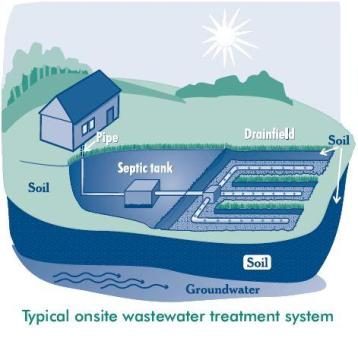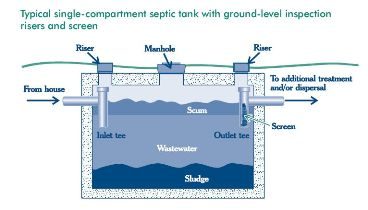 There are a number of options for your waste water, the water that has been used in your kitchen, bathroom, and laundry. Some options would mean keeping this waste separate and dispose of in different ways, but the one stop solution and most common is a septic system. As this option is the common for those who cannot get city water or in older homes this is an option that is not unknown to the common person. Though if you are considering this you need to make sure that it is an option in some suburban and urban (not practical in most cases) areas. In our area it is hard if not impossible to get approved for a new septic system as our county wants everyone connected to our city water. Since it has one of the best treatment plants in the country it’s not as big an issues for us right now. They have made this push to get and keep our waterways cleaner.
There are a number of options for your waste water, the water that has been used in your kitchen, bathroom, and laundry. Some options would mean keeping this waste separate and dispose of in different ways, but the one stop solution and most common is a septic system. As this option is the common for those who cannot get city water or in older homes this is an option that is not unknown to the common person. Though if you are considering this you need to make sure that it is an option in some suburban and urban (not practical in most cases) areas. In our area it is hard if not impossible to get approved for a new septic system as our county wants everyone connected to our city water. Since it has one of the best treatment plants in the country it’s not as big an issues for us right now. They have made this push to get and keep our waterways cleaner.
There are four main components to a typical septic system:
- A pipe to carry the waste from the home
- The actual septic tank to start the digestion process
- The drainfield to spread out the waste water
- The soil with microbes to do the final filtering and cleaning of the water
 The pipe carrys all the used (grey and black) water out of your home and into the working parts of the septic system.
The pipe carrys all the used (grey and black) water out of your home and into the working parts of the septic system.
A buried watertight container is the typical septic tank. These tanks can be made of concrete, fiberglass or polyethylene. The purpose of the tank is to hold the waste water long enough to allow solids to settle out (sludge) and oil and grease to float to the surface (scum). This allows for partial decomposition of the solid materials. To prevent the sludge and scum from leaving the tank and entering the drainfield, it is compartmentalized and has a T-shape outlet. Additional screens are recommended to make sure the solids do not make it into the drain field. On newer tanks risers with lids for easy location, inspection, and pumping of the tank.
When the wastewater has been process by the tank it exits the septic tank into a drainfield to complete it’s treatment by the soil. This wastewater is continually pushed into the drainfield every time new wastewater is introduced into the tank. Since drainfields can overload with too much liquid , flooding, and can cause sewage to come to the ground surface or create backups in your plumbing and prevent complete treatment of all watsewater. To prevent this having a reserve drainfield, as required by many states, also on your property is a good idea. This area should be cared for as well as you care for your primary drainfield.
The last part of your septic system is your soil. Soil is essential to removing contaminants from your wateswater before it is returned to your ground water. It contains microbes that are able to remove harmful bacteria, viruses, and nutrients from the wastewater. This is accomplished by the wasterwater percolating throughout the drainfield. Only suitable soil is able to do this so check with your installer or your local health department to see if you need an alternative to the final part of wastewater treatment. Another reason to look for alternative systems if to many typical systems are in one area or if your system will be to close to ground or surface water. New technology to improve the treatment process along with special care and maintenance could be used in alternative systems. Some systems use sand, peat, or plastic media to promote the treatment of the wastewater. Others can use wetlands, lagoons, aerators, or disinfection devices. Float switches, pumps, and other types of mechanical/electrical components are used often in these alternative systems.
Septic systems need to be inspected about every 3 years and pump out every 3 to 5 years. An alternative system may have additional needs or inspected/pumped more frequently. It is important and cheaper to maintain a septic system then to have to replace all or part of it due to mismanagement. Also failing and/or leaking septic systems can taint not only your but area ground water, be leached into streams, and have far reaching effects on your local environment.
pictures are curtosey of the EPA
One Response
I will be able to be able to work on anything that would need to be done